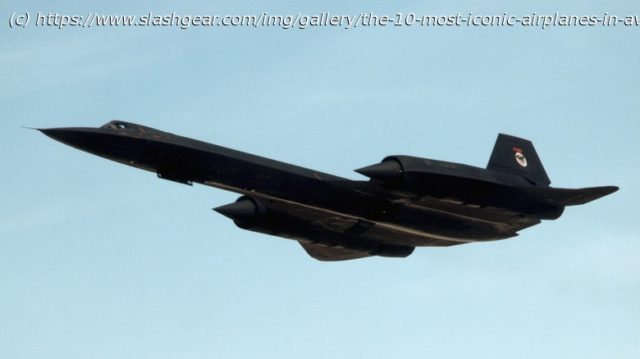Some aircraft rise above (quite literally) and have left an indelible mark on our collective psyche.
Aviation as we know it began well over a century ago, and it has brought us so many interesting flying machines that it would be impossible to take stock of all of them. Over those years, mankind has gone from flying solo in rickety contraptions with minimal amounts of power and dubious build quality. Yet, as with so many things, improvements and innovations in technology transformed primitive gliders into the extraordinarily advanced aircraft we have today.
A lot of planes, if not most, are not particularly remarkable in the eyes of the general public. For most people, if it can get you to a destination safely and relatively comfortably, that is all they need to know. Yet some aircraft rise above (quite literally) and leave an indelible mark on our collective psyche. A few inspire awe while others invoke nostalgia, and some stand as a symbol for something such as national pride or the spirit of innovation. Although there are many to choose from, here’s an exploration of 10 of the most iconic planes in aviation history.Cessna 172
As far as iconic planes go, there is one that most people will recognize but probably could not name. The Cessna 172 is a staple of general aviation airports across the country and can be found in rural and remote airstrips around the world. This plane originated in Wichita, Kansas, from a company called Cessna. It was introduced first in 1956 as a small, lightweight four-passenger airplane. Various 172 models have been produced by Cessna since its introduction. They have been powered by either Continental or Lycoming 6-cylinder engines, which added fuel injection in the late ’70s.
What makes the 172 such a great plane is that it is easy to fly and a simple plane for beginner pilots. This is how it earned its iconic status. A sizable majority of pilots licensed in the United States learn how to fly in a Cessna 172. The latest model is the 172 Skyhawk. Its low cost of ownership, in relative aviation terms, is part of its charm. A new plane one for about $432,000 with an hourly flight cost of $131. These are some of the lowest figures in the industry. But the long-lived airframe remains iconic to the thousands of pilots who earned their wings in one of these. It’s that and how recognizable it is to most people on the ground, whether or not they know what it’s called.Boeing 747
The jet age was alive and well in the late ’60s, but it differed wildly from air travel that we know today. Jet planes such as the Boeing 707 made long-haul flights possible, but they were prohibitively expensive for a majority of travelers. The key to bringing these costs down and making tickets more affordable was to add passengers, and the Boeing 747 was the first of the widebody jets to make that happen. It was introduced in 1968 and entered passenger service in 1970 on a Pan Am flight with 335 passengers. Compared to the roughly 200-passenger count of the 707 at the time, this was a huge improvement that allowed scale to lower operating costs.
Throughout the ’70s and ’80s, the 747 may have been the most recognizable commercial aircraft in the world. Flying for multiple airlines across the continents, the unique raised bubble section that housed the cockpit and, initially, a first-class lounge, could be recognized by planespotters anywhere. The 747 was the workhorse of the skies for decades, ferrying people around the planet, but also being used for cargo, including transporting a Space Shuttle on its back.
As air travel has changed and technology improved, reliance on the 747 in fleets waned. However, its production continued until the last plane was built in early 2023. Typically, 747s are used for cargo service these days, although there are some still ferrying passengers around, including the U.S. presidential plane that flies under the call sign Air Force One — an icon unto itself.Airbus A380
While the Boeing 747 was starting to get a bit long in the tooth, France’s Airbus set out to create a new sky king. Airbus come up with an alternative that had much room to spare. The Airbus A380 program started in 2000, with the first plane deliveries taking place in 2007. As a new double-decker widebody airliner, the A380 is truly behemoth. While the 747 has a hump for its second deck, the A380’s second deck runs the entire length of the plane. With this additional space, an A380 could be configured to carry up to 853 passengers, but the typical three-class configuration brings that down to 555, which is still impressive.
With a range of 8,300 nautical miles, the A380 is capable of moving passengers and cargo enormous distances with no stops. Furthermore, when configured for cargo only, it can carry 150 tons of freight. The plane is impressive in all respects. When it was first introduced, Airbus received orders primarily from airlines in Europe, the Middle East, and Southeast Asia. The U.A.E. airline Etihad has configured its planes with opulent and spacious first-class cabins called a „Residence,“ with room to move around, sleep supine, and even take a shower — for an exorbitant fare.
While Airbus managed to sell 251 of these planes, it wouldn’t be as long-lived and successful as the 747. It was introduced as Asian economies were reeling from SARS, just a year before the 2008 financial collapse. Furthermore, passenger traffic steadily declined, even before the COVID-19 pandemic became a factor.





